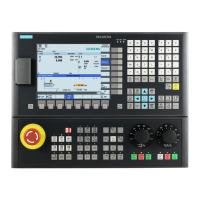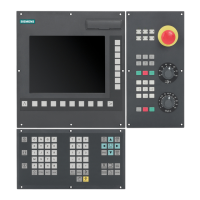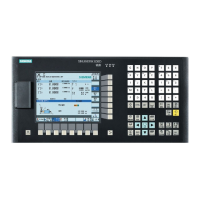Z2: NC/PLC interface signals
18.13 Synchronous Spindles (S3)
Extended Functions
904 Function Manual, 03/2013, 6FC5397-1BP40-3BA1
DB31, ...
DBX98.0
Fine synchronism
Edge evaluation: No Signal(s) updated: Cyclic
Signal state 1 or edge
change 0 → 1
The positional deviation or velocity difference between the following spindle and its leading
spindle is within the "Fine synchronism" tolerance band.
Signal state 0 or edge
change 1 → 0
The positional deviation or velocity difference between the following spindle and its leading
spindle is not within the "Fine synchronism" tolerance band.
Note:
The signal is relevant only for the following spindle in synchronous operation.
Application example Clamping of workpiece in following spindle on transfer from the leading spindle: Clamping of
the workpiece is not initiated by the PLC user program until the spindles are sufficiently
synchronized.
Corresponding to .... DB31, ... DBX84.4 (Synchronous mode)
MD37210 $MA_COUPLE_POS_TOL_FINE (threshold value for "fine synchronism")
MD37230 $MA_COUPLE_VELO_TOL_FINE ("fine" speed tolerance)
DB31, ...
DBX98.1
Coarse synchronism
Edge evaluation: No Signal(s) updated: Cyclic
Signal state 1 or edge
change 0 → 1
The positional deviation or velocity difference between the following spindle and its leading
spindle is within the "Coarse synchronism" tolerance band.
Note:
The signal is relevant only for the following spindle in synchronous operation.
Signal state 0 or edge
change 1 → 0
The positional deviation or velocity difference between the following spindle and its leading
spindle is not within the "Coarse synchronism" tolerance band.
Application example Clamping of workpiece in following spindle on transfer from the leading spindle: Clamping of
the workpiece is not initiated by the PLC user program until the spindles are sufficiently
synchronized.
Corresponding to .... DB31, ... DBX84.4 (Synchronous mode)
MD37200 $MA_COUPLE_POS_TOL_COARSE (threshold value for "coarse synchronism")
MD37220 $MA_COUPLE_VELO_TOL_COARSE ("coarse" speed tolerance)
DB31, ...
DBX98.2
Actual value coupling
Edge evaluation: No Signal(s) updated: Cyclic
Signal state 1 or edge
change 0 → 1
The actual-value coupling is active as the coupling type between the leading and following
spindles (see MD21310).
Note:
The signal is relevant only for the active following spindle in synchronous operation.
Signal state 0 or edge
change 1 → 0
The setpoint coupling is active as the coupling type between the leading and following
spindles (see MD21310).

